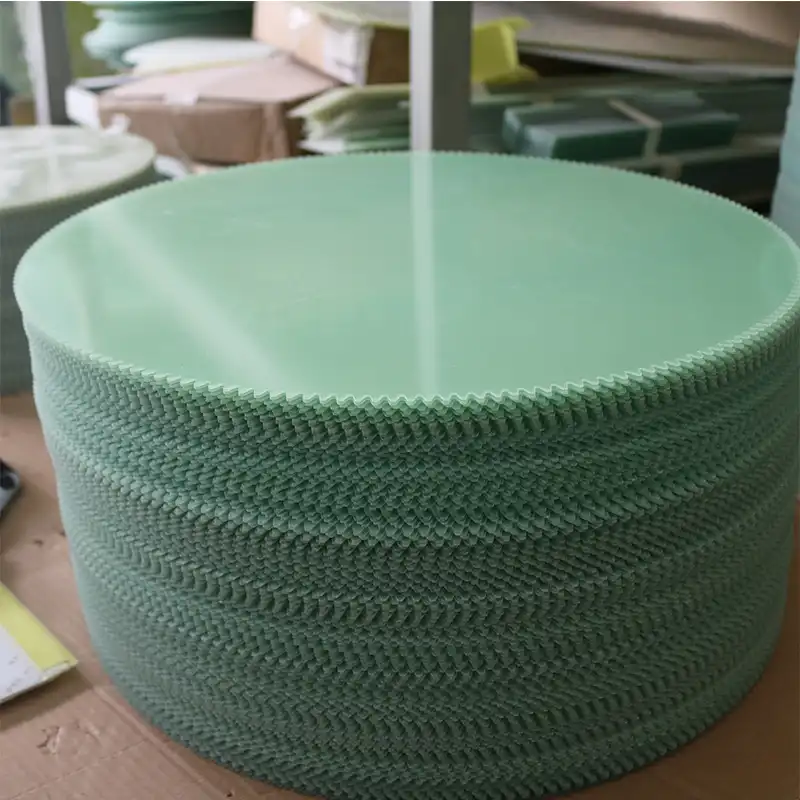Properties and Characteristics of G10 Epoxy Sheet
Chemical Composition and Manufacturing Process
G10 epoxy sheet is a composite material composed of epoxy resin reinforced with woven glass fabric. The manufacturing process involves impregnating multiple layers of glass cloth with epoxy resin under high pressure and temperature. This results in a dense, homogeneous material with superior electrical and mechanical properties. The glass fibers provide strength and dimensional stability, while the epoxy resin offers excellent electrical insulation and chemical resistance.
Electrical Properties
G10 sheet exhibits remarkable electrical insulation characteristics, making it a preferred choice in numerous electrical applications. It boasts high dielectric strength, typically ranging from 500 to 700 volts per mil, which allows it to withstand substantial electrical stresses without breakdown. The material also demonstrates low dielectric loss, ensuring minimal energy dissipation in high-frequency applications. Its volume resistivity exceeds 10^16 ohm-cm, effectively preventing current leakage across its surface or through its bulk.
Mechanical and Thermal Properties
Beyond its electrical prowess, G10 epoxy sheet offers excellent mechanical strength and thermal stability. It maintains its dimensional integrity across a wide temperature range, from cryogenic conditions to over 130°C. The material's flexural strength typically exceeds 60,000 psi, while its compressive strength can reach up to 65,000 psi. These mechanical attributes, coupled with its low coefficient of thermal expansion, make G10 sheet highly resistant to warping and distortion under varying environmental conditions.
Applications of G10 Epoxy Sheet in Electrical Systems
Power Distribution and Switchgear
In power distribution systems, G10 epoxy sheet serves as an essential component in switchgear and transformer construction. Its high dielectric strength and arc resistance make it ideal for insulating busbars and separating live components. The material's ability to maintain its properties under high temperatures and humid conditions ensures reliable performance in diverse environments, from indoor substations to outdoor installations.
Printed Circuit Boards (PCBs)
G10 sheet, often referred to as FR-4 in the electronics industry, forms the backbone of most printed circuit boards. Its excellent electrical insulation properties, combined with good machinability and dimensional stability, make it the material of choice for PCB substrates. The glass-reinforced structure provides a stable platform for copper traces and through-hole plating, ensuring signal integrity in complex electronic circuits.
Motor and Generator Insulation
In electric motors and generators, G10 epoxy sheet finds application as slot liners, phase separators, and end laminations. Its high mechanical strength allows it to withstand the centrifugal forces in rotating machinery, while its excellent electrical properties ensure proper insulation between windings. The material's resistance to oil and coolants further enhances its suitability for use in sealed motor designs.
Advantages and Considerations in Using G10 Epoxy Sheet
Benefits in Electrical Applications
G10 epoxy sheet offers numerous advantages in electrical applications. Its consistent electrical properties across a wide range of frequencies make it suitable for both power and signal applications. The material's low water absorption rate ensures stable performance in humid environments, reducing the risk of electrical breakdown due to moisture ingress. Additionally, G10 sheet's flame-retardant properties contribute to enhanced safety in electrical systems, meeting stringent fire safety standards.
Machining and Fabrication Considerations
While G10 epoxy sheet possesses excellent machinability, certain considerations must be taken into account during fabrication. The material's abrasive nature due to its glass content can lead to rapid tool wear. Specialized carbide or diamond-tipped tools are often recommended for optimal cutting and drilling operations. Proper dust extraction systems are essential to manage the fine particles generated during machining, ensuring worker safety and preventing contamination of sensitive electrical components.
Environmental and Regulatory Aspects
As environmental concerns gain prominence, the use of G10 epoxy sheet in electrical applications requires careful consideration of regulatory compliance. While the material itself is inert and non-toxic, the manufacturing process and end-of-life disposal may have environmental implications. Some formulations of G10 sheet comply with RoHS (Restriction of Hazardous Substances) directives, making them suitable for use in environmentally conscious electrical designs. Manufacturers and users should be aware of regional regulations governing the use and disposal of composite materials in electrical equipment.
Conclusion
G10 epoxy sheet stands as a cornerstone material in electrical applications, offering a unique blend of electrical insulation, mechanical strength, and thermal stability. Its versatility enables its use across a wide spectrum of electrical systems, from power distribution equipment to intricate electronic circuits. As electrical technologies continue to evolve, the role of G10 sheet remains crucial in ensuring the reliability, safety, and performance of modern electrical systems. By understanding its properties and applications, engineers and designers can leverage the full potential of G10 epoxy sheet to create innovative and efficient electrical solutions for the future.
Contact Us
For more information about G10 epoxy sheet and its applications in electrical systems, please contact us at info@jhd-material.com. Our team of experts is ready to assist you in selecting the right materials for your specific electrical engineering needs.






